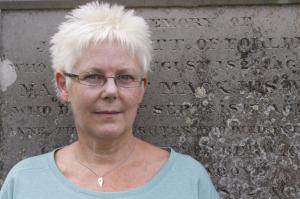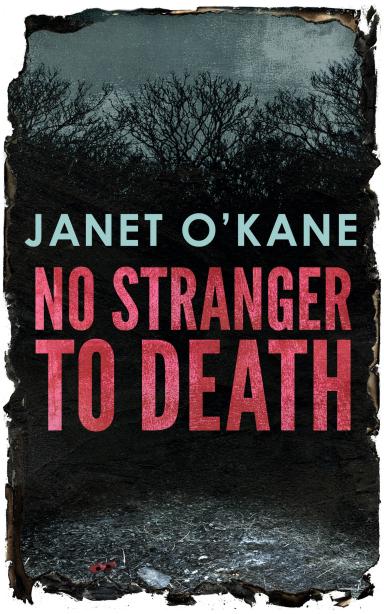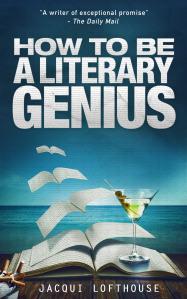 In a difficult market more and more writers are deciding to self-publish their fiction and one of the challenges they face is attracting a readership when many people have an unfavourable perception of books which don’t carry the endorsement of a publishing house. Whilst some of the common concerns about quality are undoubtedly justified, it seems unfair to bundle all self-published authors together – plenty of talented writers have found success this way. I don’t often read self-published novels* unless I know the author or the book comes recommended, but I’ve followed today’s guest Janet O’Kane on Twitter for long enough to see how seriously she’s approached the whole process of self-publishing her debut crime novel. I invited her to the Literary Sofa to explain how and why she did it (my mini-review follows):
In a difficult market more and more writers are deciding to self-publish their fiction and one of the challenges they face is attracting a readership when many people have an unfavourable perception of books which don’t carry the endorsement of a publishing house. Whilst some of the common concerns about quality are undoubtedly justified, it seems unfair to bundle all self-published authors together – plenty of talented writers have found success this way. I don’t often read self-published novels* unless I know the author or the book comes recommended, but I’ve followed today’s guest Janet O’Kane on Twitter for long enough to see how seriously she’s approached the whole process of self-publishing her debut crime novel. I invited her to the Literary Sofa to explain how and why she did it (my mini-review follows):
I chose to self-publish at a relatively early stage after finishing my crime novel, No Stranger to Death. I wanted to go down that route before frustration set in at not being able to get a traditional publishing deal, before it felt like a last resort. No task ever goes well if you’re angry about having to do it.
I had submitted my novel to several agents during 2012. They were, in the main, kind but dismissive, all bar one who asked to see the full manuscript. She telephoned a few weeks later to say she had enjoyed reading it, that it was ‘very good’, but despite this she wasn’t going to take me on. No Stranger to Death was too ‘mid-list’, not different enough to attract a publisher in the current climate.
My husband expected me to be devastated by this rejection, but I wasn’t. Instead, I regarded it as affirmation that my novel deserved to find an audience. I began to think maybe I should go out and find that audience myself.
I knew this was possible. There are shining examples of successful self-publishing in crime fiction, like Mel Sherratt, who is a friend and an inspiration. Then, in late 2012, I attended an event for writers held here in the Scottish Borders. Local author Peter Flannery spoke about self-publishing his novel, First and Only, and how the book’s sales had exceeded his wildest expectations (it was No.1 in the Kindle Psychological Crime, Thrillers and Mystery chart for three months).
When I decided to self-publish, I took Peter up on his offer of advice. He was incredibly generous with the information he shared, and was also by my side (via email) when I needed it most, as I uploaded my novel to Amazon. But I’ve raced ahead somewhat …
I mentioned my decision to several people at the Theakston’s Crime Writing Festival in Harrogate in July 2013. The response ranged from embarrassed silence, to ‘Good for you’ then an abrupt change of subject, to genuine interest. A few unpublished writers said (confidentially) they were considering doing the same.
The stigma attached to self-publishing mainly revolves around issues of quality. There’s an assumption that anything not accredited by a traditional publisher will suffer from poor writing, editing and formatting, topped off by a naff cover. I was determined to challenge that assumption. However, I’m not a graphic designer, my IT know-how is minimal, and it’s impossible to edit one’s own writing effectively. So, in my case, self-publishing became a misnomer: I decided to buy in the expertise I lacked.

I read up on book-cover design and looked at many examples, good and bad. The key to producing an effective cover is to remember it isn’t a work of art: it has a job to do. As I’m a debut author, my cover had to tell prospective readers what they could expect to find inside. It also needed to work in a variety of sizes, starting from a mere thumbnail. When Kim showed me his design ideas, I was bowled over by how well he had succeeded in meeting these goals.
I found both my editor, Caroline Smailes at BubbleCow, and Jo Harrison, who formatted my e-book, via Twitter. Being edited was nerve racking. Apart from that agent, no one else had read No Stranger to Death, so I didn’t know what to expect. However, Caroline’s comments were both reassuring and insightful, and it became a far better book when I incorporated her suggested changes.
Other self-published authors assured me I was capable of formatting my e-book myself. However, I preferred to put it into the hands of an expert and get on with tasks, like writing marketing material, that I knew I could do. I did, though, successfully format the paperback. I’d be lying if I said I sailed through the technical side of putting my book on to Amazon, but the Kindle Direct Publishing and CreateSpace websites are well designed and take you step by-step through the process.
The e-book of No Stranger to Death appeared on Amazon on 19 November, and I officially launched it via email, Twitter and Facebook the next day. In its first week it reached the Kindle Top 20 of Scottish crime novels. Many authors don’t bother bringing out paperbacks of their books but I knew I’d made the right decision to offer a physical book too when so many people told me they wanted to read it that way. The paperback is also a thing of beauty (to me, at least) and tangible proof I am now published. No Stranger to Death has been well received: every review thus far has given it five stars. Because I invested in outside help with important aspects of my book, I’m proud of how it has turned out. And the best part of my self-publishing journey? Having readers tell me they enjoyed my novel so much that they can’t wait for the next one!
Many thanks to Janet for this interesting and eye-opening piece. I’d be very interested to hear other people’s views and experiences of self-publishing.
In Brief: My View of No Stranger to Death
The overall impression is that Janet O’Kane’s commitment to quality has paid off. The cover is atmospheric and intriguing. Even though the version I read wasn’t the final Kindle edition, it was better presented than many e-books of traditionally published novels. The professional edit was a good investment: Janet’s writing is smooth and lively and she shows herself to be in control of a complex and involving plot. The vivid depiction of a close-knit rural community in the Scottish Borders was a strong point, capturing the ups and downs of everyone knowing everyone else’s business, with some entertaining characters and shrewd observations of human nature. In general this would appeal to fans of the cosier (for want of a better term) end of crime fiction although personally I found the brief diversion into edgier territory rather uncomfortable.

*I have no plans to feature self-published fiction on a regular basis.
*POSTSCRIPT*
COMING SOON TO A SOFA NEAR YOU – FICTION HOT PICKS 2014 !
After three months in the making, on Tuesday 17 December I will be publishing my Fiction Hot Picks of 2014 – a diverse selection of eleven brilliant titles. There will also be a competition – three winners will get to pick the title of their choice from my recommendations.

